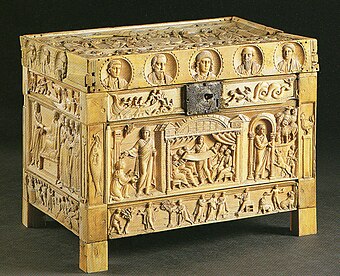Revival of classical art
Early Christian art and architecture or Paleochristian art is the art produced by Christians or under Christian patronage from the earliest period of Christianity to, depending on the definition used, sometime between 260 and 525. In practice, identifiably Christian art only survives from the 2nd century onwards. After 550 at the latest, Christian art is classified as Byzantine, or of some other regional type.
It is hard to know when distinctly Christian art began. Prior to 100, Christians may have been constrained by their position as a persecuted group from producing durable works of art. Since Christianity was largely a religion of the lower classes in this period, the lack of surviving art may reflect a lack of funds for patronage, and simply small numbers of followers. The Old Testament restrictions against the production of graven (an idol or fetish carved in wood or stone) images (see also Idolatry and Christianity) may also have constrained Christians from producing art. Christians may have made or purchased art with pagan iconography, but given it Christian meanings, as they later did. If this happened, "Christian" art would not be immediately recognizable as such.
Early Christianity used the same artistic media as the surrounding pagan culture. These media included fresco, mosaics, sculpture, and manuscript illumination. Early Christian art used not only Roman forms but also Roman styles. Late classical style included a proportional portrayal of the human body and impressionistic presentation of space. Late classical style is seen in early Christian frescos, such as those in the Catacombs of Rome, which include most examples of the earliest Christian art.
The Brescia Casket, 4th-century ivory
Early Christian art and architecture adapted Roman artistic motifs and gave new meanings to what had been pagan symbols. Among the motifs adopted were the peacock, Vitis viniferavines, and the "Good Shepherd". Early Christians also developed their own iconography; for example, such symbols as the fish (ikhthus) were not borrowed from pagan iconography.
Early Christian art is generally divided into two periods by scholars: before and after either the Edict of Milan of 313, bringing the so-called Triumph of the Church under Constantine, or the First Council of Nicea in 325. The earlier period being called the Pre-Constantinian or Ante-Nicene Period and after being the period of the First seven Ecumenical Councils. The end of the period of early Christian art, which is typically defined by art historians as being in the 5th–7th centuries, is thus a good deal later than the end of the period of early Christianity as typically defined by theologians and church historians, which is more often considered to end under Constantine, around 313–325



